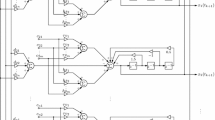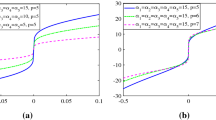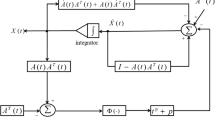Abstract
It is well known that noise is inevitable in real world, especially in the case of solving time-variant matrix inversion. Therefore, it is more necessary to study the algorithm with bias noises to solve time-variant matrix inversion. This paper investigates discrete-time neural network with two classes of bias noises for solving time-variant matrix inversion, and its application to robot tracking based on the property of second-order differential equation. Firstly, the model is presented and some indispensable propaedeutics are given. Then, continuous-time and discrete-time neural network with two classes of bias noises is designed, respectively. Their convergence and finite-time stability are also theoretically analyzed. Finally, the proposed models are applied to a five-link robot tracking. Numerical simulations demonstrate the superiority and effectiveness of our method.











Similar content being viewed by others
References
Buss SR (2004) Introduction to inverse kinematics with Jacobian transpose. Pseudo inverse and damped least squares methods. Technical report. University of California, San Diego
Stephen LC, Carl DM (2009) Generalized inverses of linear transformations. Society for Industrial and Applied Mathematics, Philadephia
Mao M, Li J, Jin L, Li S, Zhang Y (2016) Enhanced discrete-time Zhang neural network for time-variant matrix inversion in the presence of bias noises. Neurocomputing. https://doi.org/10.1016/j.neucom.2016.05.010
Shen YJ, Xia XH (2008) Semi-global finite-time observers for nonlinear systems. Automatica 44:3152–3156
Chen J, Han D, Nie H, Cheng M (2014) Dual quaternion-based inverse kinematics of dexterous finger. J Vibroeng 16:2813–2820
Li S, Zhang Y (2018) Neural networks based single robot arm control for visual servoing. In: Neural networks for cooperative control of multiple robot arms. Springer, Singapore, pp 1–11
Cho CN, Hong JT, Kim HJ (2018) Neural network based adaptive actuator fault detection algorithm for robot manipulators. J Intell Robot Syst 2018(1):1–11. https://doi.org/10.1007/s10846-018-0781-0
Fan Y, Nagy JG (2012) An efficient computational approach for multiframe blind deconvolution. J Comput Appl Math 236:2112–2125
Bajodah AH (2013) Inertia-independent generalized dynamic inversion feedback control of spacecraft attitude maneuvers. Acta Astronaut 88:98–107
Zhang Y, Li Z, Li K (2011) Complex-valued Zhang neural network for online complex-valued time-varying matrix inversion. Appl Math Comput 217:10066–10073
Zhang Y, Ge SS (2005) Design and analysis of a general recurrent neural network model for time-varying matrix inversion. IEEE Trans Neural Netw 16:1477–1490
Zhang Z, Zheng L, Weng J, Mao Y, Lu W, Xiao L (2018) A new varying-parameter recurrent neural-network for online solution of time-varying Sylvester equation. IEEE Trans Cybern 99:1–14
Miao P, Shen YJ, Xia XH (2014) Finite time dual neural networks with a tunable activation function for solving quadratic programming problems and its application. Neurocomputing 143:80–89
Miao P, Shen YJ, Li YJ, Bao L (2016) Finite-time recurrent neural networks for solving nonlinear optimization problems and their application. Neurocomputing 177:120–129
Li L, Jian J (2015) Exponential convergence and Lagrange stability for impulsive Cohen–Grossberg neural networks with time-varying delays. J Comput Appl Math 277:23–35
Shi Y, Zhang Y (2018) Discrete time-variant nonlinear optimization and system solving via integral-type error function and twice ZND formula with noises suppressed. Soft Comput 22(21):7129–7141
Zhang Y, Mu B, Zheng H (2013) Link between and comparison and combination of Zhang neural network and quasi-Newton BFGS method for time-varying quadratic minimization. IEEE Trans Cybern 43:490–503
Guo D, Zhang Y (2012) Zhang neural network, Getz–Marsden dynamic system, and discrete-time algorithms for time-varying matrix inversion with application to robots’ kinematic control. Neurocomputing 97:22–32
Jin L, Zhang Y, Li S (2016) Integration-enhanced Zhang neural network for real-time-varying matrix inversion in the presence of various kinds of noises. IEEE Trans Neural Netw Learn Syst. https://doi.org/10.1109/TNNLS.2015.2497715
Zhang Y, Jin L, Guo D, Yin Y, Chou Y (2015) Taylor-type 1-step-ahead numerical differentiation rule for first-order derivative approximation and ZNN discretization. J Comput Appl Math 273:29–41
Li S, Chen S, Li B (2013) Accelerating a recurrent neural network to finite-time convergence for solving time-varying Sylvester equation by using a sign-bi-power activation function. Neural Process Lett 37:189–205
Miao P, Shen YJ, Huang YH, Wang YW (2015) Solving time-varying quadratic programs based on finite-time Zhang neural networks and their application to robot tracking. Neural Comput Appl 26(3):693–703
Hogan N, Sternad D (2009) Sensitivity of smoothness measures to movement duration, amplitude, and arrests. J Mot Behav 41(6):529–534
Balasubramanian S, Melendez-Calderon A, Burdet E (2012) A robust and sensitive metric for quantifying movement smoothness. IEEE Trans Biomed Eng 59(8):2126–2136
Balasubramanian S, Melendez-Calderon A, Roby-Brami A, Burdet E (2015) On the analysis of movement smoothness. J Neuroeng Rehab 12(1):112
Acknowledgements
This work was supported by the National Science Foundation of China (61374028), the Key Scientific Research Foundation of Education Bureau of Henan Province, China (Grant No. 19A140021), and the 2016 Social science and economics’ association research topics in Henan Province (SKL-2016-3868). The paper has not been published and will not be submitted elsewhere for publication. In order to improve the quality of the article, with the consent of the original author and Zhiqiang Zhang, we invited Zhiqiang Zhang to revise the article. He added the finite-time stability to the revised paper.
Author information
Authors and Affiliations
Corresponding author
Ethics declarations
Conflict of interest
All authors declare that they have no conflict of interest.
Additional information
Publisher's Note
Springer Nature remains neutral with regard to jurisdictional claims in published maps and institutional affiliations.
Rights and permissions
About this article
Cite this article
Miao, P., Wu, D., Shen, Y. et al. Discrete-time neural network with two classes of bias noises for solving time-variant matrix inversion and application to robot tracking. Neural Comput & Applic 31, 4879–4890 (2019). https://doi.org/10.1007/s00521-018-03986-w
Received:
Accepted:
Published:
Issue Date:
DOI: https://doi.org/10.1007/s00521-018-03986-w




